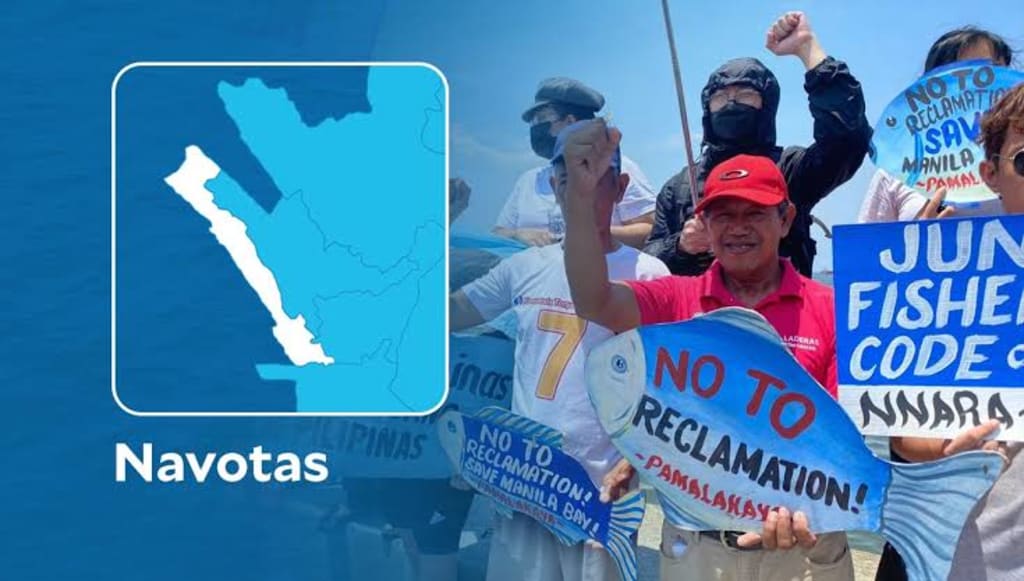Reclamation Project in Navotas: Fishing Capital No More?
The fight of the fisher folks in Navotas

The simplest method of land reclamation involves simply filling the area with large amounts of
heavy rock and/or cement, then filling it with clay and soil until the desired height is
reached.Land reclamation is associated with some dangers, such as flooding and soil liquefaction
and reclaimed lands are expensive and can be damaging to corals and marine life. It also changes
the quality of the surrounding areas of water.
The Navotas Coastal Bay Reclamation Project or the Navotas Boulevard Business Park is an
under-construction commercial and business center in Navotas.The 650-hectare reclamation
project in Navotas was approved by the Philippine Reclamation Authority in 2018 and has been
under construction since 2019.The development is envisioned to create a mixed-use community
with residential, institutional, commercial, and industrial areas suitable for port facilities, marine,
and tourism. Its master plan was designed by Surbana Jurong.
The processes of land reclamation can cause long and short-term problems which are harmful to habitats. There is an obvious change where the land is created, but habitats can be disturbed or destroyed in the process of gathering the earth or dredging for materials to add to the land.
They stressed that reclamation and dredging projects in Manila Bay have caused a significant decline in fish populations, depletion of marine resources, an increase in invasive marine species, and lead to coastal and land erosion. These projects also disrupt their livelihoods and displace communities.
According to Baure, an Agham Scientist Along the coastline of Manila Bay scientist found out
the there are many mangroves and larvae also in it's nearby cities. But if those matured
mangroves will be cut to give way to the proposed reclamation projects. Cutting these, will
expose communities to hazards like storm surges and flooding as mangroves also serve as a
“natural defense” in times of typhoons. Reclamation can also exacerbate the impacts of sea level
rise due to climate change.
Known as the “Fishing Capital of the Philippines,” Navotas has the third-largest fish port in Asia
and the largest in Southeast Asia. It is home to thousands of fishermen who rely on Manila Bay’s
marine resources, fishing as far as Cavite province.
A fishing community in Tanza, Navotas faces eviction with the implementation of the
P57.4-billion (US $ 1.19 million) Navotas Coastal Bay Reclamation Project. Residents in the
Community were informed last December by a local “caretaker” hired by San Miguel
Corporation that they needed to vacate the land where they have lived for decades to give way to the 576-hectare reclamation project. Families were asked to relocate to a nearby temporary
shelter site, which they describe that is prone for flooding and unsafe space for them most
especially for childrens.
When the project was first announced, Navotas Mayor claimed that there will be no existing
houses that will be affected by the project. However, groups of fishermen's and citizens living
there know that it threatens the livelihoods of more than 1,000 fishermen, fish workers, and
operators of fishing structures.With that losing of a vital local food source will result in higher
food prices, mainly impacting the poor communities.
Residents in the area, forced to remove their mussels farms, and stationary fishing traps in the
area. People were given only 15,000 pesos in cash as payment to their crop. But, if is not enough
to buy all those crops they took care of for months.
Navotas fisherfolk rally against demolition and reclamation to save their livelihoods. Fisherfolk from Navotas have been rallying against demolition and reclamation to save their livelihoods, namely farming and selling mussels or tahong. When times come, they need to leave the place where they have lived for decades. It feels like
living again and starting from scratch, because the government doesn't have detailed plans for
them to secure their livelihood and work.
About the Creator
Enjoyed the story? Support the Creator.
Subscribe for free to receive all their stories in your feed. You could also pledge your support or give them a one-off tip, letting them know you appreciate their work.





Comments
There are no comments for this story
Be the first to respond and start the conversation.